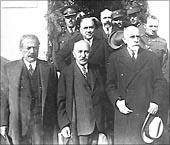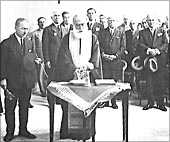| Introduction: The main protagonists

 It has been astutely stated that the basis of massive support for the political forces of the period came from specific classes (social), groups (professional etc.) and regions. Without doubt, there were two specific ways by which the application of any party strategies was formulated:
the 'charisma' of the politicians leading each bloc,
and clientele networks. Especially during the first phase of the period under examination,
that is until the mid-1930s, these methods
were the most convenient alternative forms of mass mobilization.
Besides, the frequency of extra-institutional overthrows (coups, riots etc.), proves that parliamentary confrontation and military intervention
It has been astutely stated that the basis of massive support for the political forces of the period came from specific classes (social), groups (professional etc.) and regions. Without doubt, there were two specific ways by which the application of any party strategies was formulated:
the 'charisma' of the politicians leading each bloc,
and clientele networks. Especially during the first phase of the period under examination,
that is until the mid-1930s, these methods
were the most convenient alternative forms of mass mobilization.
Besides, the frequency of extra-institutional overthrows (coups, riots etc.), proves that parliamentary confrontation and military intervention

 on the part of the two large blocs, Venizelists and anti-Venizelists,
must be considered as two complementary methods of acquiring
power.
on the part of the two large blocs, Venizelists and anti-Venizelists,
must be considered as two complementary methods of acquiring
power.
To the extent that the Greek political parties continued in the inter-war period to be governed by leading figures and not by political principles
and policies, the constant turbulent changes of public life
should be seen in perspective.
|






